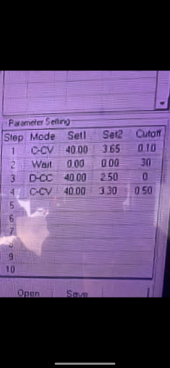Hey, my X32 docan eve 280ah cells turned up earlier than predicted and I don’t have my array built. It’s likely I won’t put them into commission for prob about 3 months.
So far, I have checked them externally, confirmed each voltage (all are around 3.29v) and am building a spring compression pack for them (X2 16 cell packs).
I have a EBC-A40L and plan on capacity test on them all individually (parameters to be confirmed on the charge/discharge settings).
So I am considering whether to:-
Capacity test them individually and discharge them to 30% SOC and then leave them until I’ve built the array.
Capacity test individually, discharge them to 30% SOC, connect in parallel and leave them for a while to equalize, put them in series, hook them up to my inverter and BMS so they are setup, balanced and ready to go.
Capacity test individually, leave them fully charged, connect in parallel and leave them for a while to equalize, hook them up and test some loads on the inverter to bring them down to 30%.
I can see benefits in all the options, but as this is a first time process I’m unsure of the best plan or pitfalls or difficulties I may have.
I have read the top balancing resources and had a search around as regard similar scenarios.
So far, I have checked them externally, confirmed each voltage (all are around 3.29v) and am building a spring compression pack for them (X2 16 cell packs).
I have a EBC-A40L and plan on capacity test on them all individually (parameters to be confirmed on the charge/discharge settings).
So I am considering whether to:-
Capacity test them individually and discharge them to 30% SOC and then leave them until I’ve built the array.
Capacity test individually, discharge them to 30% SOC, connect in parallel and leave them for a while to equalize, put them in series, hook them up to my inverter and BMS so they are setup, balanced and ready to go.
Capacity test individually, leave them fully charged, connect in parallel and leave them for a while to equalize, hook them up and test some loads on the inverter to bring them down to 30%.
I can see benefits in all the options, but as this is a first time process I’m unsure of the best plan or pitfalls or difficulties I may have.
I have read the top balancing resources and had a search around as regard similar scenarios.




